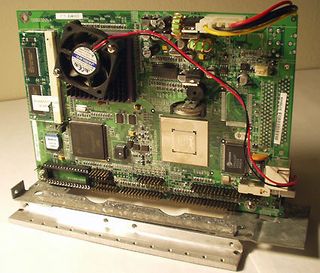RAID on Rye
Lord Of The RAIDs - The Two Toasters

Dave Goeke: Both systems are fully-featured x86 computers. There is an SBC (single board computer) measuring about 6 by 8 inches inside. I have no idea who made the motherboards; they have no identifiers and do not POST any BIOS string.
The processor is a Cyrix MediaGX 200. There is a 32 MB notebook-style memory module, a so-called small outline DIMM (SO-DIMM). The motherboard has headers for UltraATA, simple video, Ethernet, keyboard, power, and a panel of activity LEDs. Cables for most ports run to the underside of the systems. The power supply is a PCB measuring about 2 by 3 inches with a single 5 V lead that powers the drives, the motherboard and a pair of small fans. One of them cools the CPU, the other sits above the drives. My older system has a pair of mirrored 8.6 GB UltraATA/66 drives, and the latest one has a pair of mirrored 20 GB UltraATA//66 drives.
THG: Can you give us some more details about the operating system?
Dave Goeke: The ApplianceWare OS runs file services (SMB, AFP, NFS), networking, DHCP, software RAID, sendmail for event notification, and a web server for access to the administrative tools. Linux software RAID allows configuration of RAID 5 with a hot spare (given enough drives), mirroring, or striping. A browser-based administrative tool allows users to configure, monitor, and manage the system; set and change RAID level, configure DHCP, manage security, create shares, and more.
THG: So it's pretty much a full-blown operating system, and as I can see these units are working pretty well. Could you show our readers how you physically managed to install the computer components into the toaster housing? I mean, you can't just go and buy any old toaster and expect it to have motherboard mounting holes or a 3.5" drive bay.
Dave Goeke: Who knows, maybe that is going to change if the right people read this article. :-) Toaster RAID is built by first gutting a toaster, then installing a few heavy rails to support hard drives. The motherboard is either installed on a rail or attached to a drive. The remaining components such as the power supply, switches, activity LEDs and interfaces are attached to the drives.
Stay on the Cutting Edge
Join the experts who read Tom's Hardware for the inside track on enthusiast PC tech news — and have for over 25 years. We'll send breaking news and in-depth reviews of CPUs, GPUs, AI, maker hardware and more straight to your inbox.
Current page: Lord Of The RAIDs - The Two Toasters
Prev Page Why A Toaster? Next Page Parts, Pieces And Ingredients Of Toaster RAIDMost Popular

